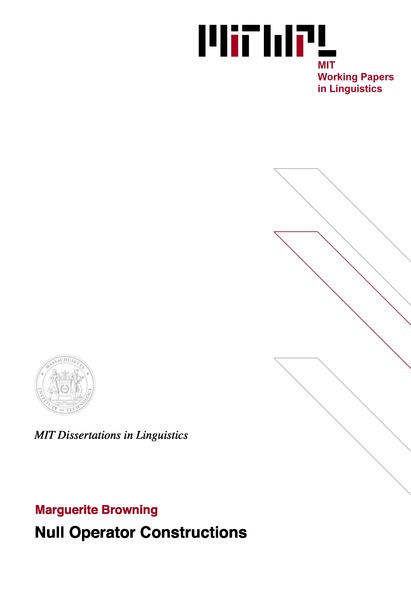Null Operator Constructions
M. Browning, 1987
ABSTRACT
This dissertation defends the hypothesis that certain constructions involve covert A'-movement resulting in the creation of A'-chains headed by null categories commonly referred to as "null operators." The constructions which have been widely analyzed as involving null operators fall into two categories. In the first category, designated "OWM ("On WHmovement") constructions", are relative clauses (tensed and infinitival), purpose clauses, degree clauses, adjectivai complements, clefts and comparatives, all of which are treated as covert wh-movement structures in Chomsky (1977). More recently, the null operator hypothesis has been extended to parasitic gap constructions, which constitute the second category.
The goal of this dissertation is to develop an analysis of the nature of null operator chains and the conditions which apply to them which will account for the similarities and differences between the two categories of constructions in a unified manner. Three types of constraints are discussed and proposed: constraints governing the licensing of the null. Operator itself, the licensing of the variable created by null operator movement and the licensing of the null operator chain as a whole. Chapter one contains a history of the development of the null operator analysis, reviews the basic phenomena to be examined and sets out the framework, essentially that of Chomsky (1986a, 1986b), within which the research has been carried out. Chapter two examines the relation between predication and the operators, both overt and null, which allow clausal categories to function as predicates ic OWM constructions. It is proposed that predication relations which are not licensed by 8-role assignment must be licensed by the existence of an "agreement chain" between the subject of predication and a predicate internal category. An agreement chain exists when two categories are connected by an unbroken sequence of independently motivated instances of agreement, e.g. subject-predicate agreement, SPEC-HEAD agreement, etc. It is further argued that null operators are pure pronominals, i.e. pro, and that the agreement chain which licenses predication is sufficient to identify A'- pro.* Since A'-pro in OWM constructions receives phi-features via the agreement chain, it is licensed as the head of an A'- chain. In chapter three it is shown that the fundamental difference between OWM constructions and parasitic gap constructions is that A'-pro in the latter does not participate in an agreement chain and, therefore, does not receive phi-features. The result is that A'-pro in parasitic gap constructions is not licensed to head a chain; however, under the appropriate assumptions about the constraints governing A'-chains, unidentified A'-pro may act as an intermediate empty category. This position is embedded in an analysis of parasitic gap constructions which treats the parasitic chain and the "real" chain as a single "complex chain" derived by chain formation, a nonexceptional, non-construction specific process. The Subjacency Condition is interpreted as a condition on chain links which applies at SS to the output of all chain formation operations and which, therefore, governs the formation of complex chains. Conditions on the identification of variables are also shown to affect the distribution of parasitic gaps. At LF A/-pro in these constructions, like other intermediate empty categories in argument chains, deletes via Affect a, yielding representations identical to those resulting from the Chomsky (1982) analysis, in which the matrix operator directly binds two variables. The anti-c-command constraint is once again analyzed as a Binding Condition C violation. The chapter ends with some speculative remarks concerning the typology of empty categories and the nature of chains. Other aspects of A'-chains involving both null and overt operators are explored in chapter four, in particular, the greater sensitivity of extracted subjects in a variety of contexts to the presence of intervening barriers. It is shown that this sensitivity is not a unified phenomenon and that it does not motivate certain revisions of the ECP which have been proposed in recent work. The marginality of subject gaps in OWM constructions, parasitic gap constructions and within certain types of islands in English is attributed to the Subjacency Condition, in a revised relativized form which imposes a stricter SS bounding constraint on non-complement chains than on complement chains. Another group of constructions which exhibit stronger violations and which share the property that extraction of an argument requires the obligatory presence of an intermediate empty category in an A/-position at LA , are brought within the scope of the ECP by means of a condition on LF argument chains involving A'-positions. A discussion of several other topics, including the appropriate formulation of the Minimality Condition, the nature of antecedent government and head government, the proper definition of "barrier", ends the chapter.

